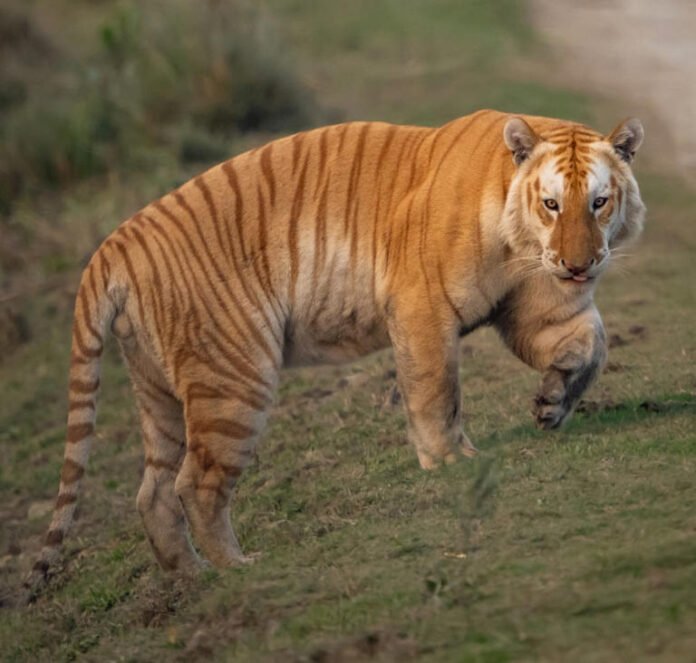A rare golden tiger has been sighted in Assam’s famed Kaziranga National Park, igniting excitement among wildlife enthusiasts and conservationists alike. The stunning feline, distinguished by its unique golden-hued coat and faint, pale stripes, was spotted alongside its mother and siblings during a safari in the park’s Kohora range.
This majestic sighting is not only rare but also symbolic of the ecological treasures that the Indian subcontinent continues to harbor. The golden tiger, also known as the golden tabby tiger, is an extremely rare color morph resulting from a recessive genetic mutation that affects pigmentation. Unlike the standard Bengal tiger with its bright orange coat and bold black stripes, the golden variant sports a lighter, golden-yellow hue with subdued markings, giving it an almost mythical appearance.
The appearance of this golden cub in Kaziranga has sparked widespread fascination, particularly among photographers and tourists who were fortunate to witness the spectacle. Images of the tiger have since gone viral on social media, further intensifying interest in this enigmatic creature and the rich biodiversity of the park.
While the sighting is undeniably exciting, it also brings attention to the genetic dynamics at play within tiger populations. Experts believe that such rare mutations may be the result of limited genetic diversity, often caused by inbreeding within isolated populations. Although not necessarily harmful on its own, the frequent occurrence of such traits can raise concerns about the long-term health of the species. Conservationists are emphasizing the need for detailed genetic studies to determine the implications of this rare appearance and what it might reveal about the broader state of India’s tiger habitats.
Kaziranga National Park, a UNESCO World Heritage Site, is already celebrated for its success in conserving the one-horned rhinoceros and serving as a sanctuary for a wide range of wildlife including elephants, swamp deer, and over 500 species of birds. The golden tiger sighting now adds a new chapter to the park’s storied legacy, reinforcing its status as one of India’s most vital conservation landscapes.
The rare sighting also brings into focus the dual nature of wildlife tourism. On one hand, such events can draw positive attention to conservation areas, increase funding, and encourage people to appreciate the importance of biodiversity. On the other hand, heightened tourist activity can risk disrupting the fragile ecosystems these species inhabit. Park authorities now face the delicate challenge of managing increased interest while ensuring the animals are not disturbed by growing crowds of onlookers.
Local guides and forest officials have reported an uptick in visitors since news of the golden tiger broke, many hoping to catch a glimpse of this once-in-a-lifetime spectacle. While tourism brings economic benefits to the region, experts emphasize the importance of responsible wildlife watching practices, reminding visitors that conservation must remain the top priority.
In the broader scheme, the sighting of this golden marvel may serve as a wake-up call for deeper investment in habitat preservation, wildlife corridors, and scientific research. India’s tiger population has seen a positive resurgence over the past decade due to focused conservation programs, but challenges like habitat fragmentation, poaching, and human-wildlife conflict continue to pose serious threats.
As Kaziranga basks in the glow of this golden wonder, it also shoulders the responsibility of leading conversations around conservation and the need to protect not just rare tigers, but the ecosystems that allow such natural marvels to exist. The golden tiger is not just a visual spectacle—it is a symbol of both the beauty and fragility of our wild world.
For now, the golden tiger remains a shimmering mystery in the forests of Assam, a living testament to nature’s surprises—and a powerful reminder of why they must be preserved.




